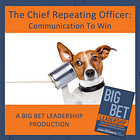Boost Morale & Efficiency by >50%, and It Doesn't Require AI
The Playbook for Designing & Running High-Impact Business Meetings
Meetings are indispensable when you don't want to do anything
— John Kenneth Galbraith
I asked ChatGPT for quotes about meetings—and how they suck the time, energy, and will to live out of teams. The results?
“If you want to kill any idea in the world, get a committee working on it.” — Charles Kettering
“The least productive people are usually the ones who are most in favor of holding meetings.” — Thomas Sowell
“[Meetings are] a huge waste of time, and they’re costly. It’s not one hour; it’s 10, because you pulled 10 people away from their real work.”
— Jason Fried“Excessive meetings are the blight of big companies and almost always get worse over time.” — Elon Musk
"Meetings are by definition a concession to a deficient organization. For one either meets or one works. One cannot do both at the same time."
— Peter Drucker“The hard truth is, bad meetings almost always lead to bad decisions, which is the best recipe for mediocrity.” — Patrick Lencioni
“If you had to identify, in one word, the reason why the human race has not achieved, and never will achieve, its full potential, that word would be 'meetings.” — Dave Berry
“Meetings are the last resort, not the first option. Five people in a room for an hour isn’t a one-hour meeting, it’s a five-hour meeting.” — Jason Fried
“Meetings are what happens when people aren't working.” — Elon Musk
Any arguments? I didn’t think so.
Bad meetings—aka most meetings—are the silent killers of energy, clarity, and momentum. But well-designed meetings? They’re catalysts, force multipliers, part protein shake, part high-octane Red Bull.
Sadly, too often, meetings are just a cage with a calendar invite.
Don’t miss the free custom GPT for meeting design at the bottom of this newsletter.
Please see the “hold harmless” section also.
Here’s the hard truth: we’re hooked on meetings that don’t matter.
When you're in a meeting, you're usually not designing. Not solving. Not thinking.
You're definitely not moving fast. You're just… talking. Or doing email.
Most meetings are the lazy way to pretend work is happening.
I believe in focus. Writing and memos aren’t busywork—they’re tools for real thinking, collaboration, and low-fidelity prototyping.
That’s how you create clarity and momentum.
Not by cramming more people into more rooms with more slides.
[Read this Digital Leader article to expand on this topic]
How do we reclaim our time—and our effectiveness?
Don’t be fooled. This is not a minor adjustment for a business. What I’m proposing has the potential for dramatic business improvement. It is a transformation. These types of culture and operating model redesigns are Big Bets™ and need to be recognized and ran accordingly. Or they will fail.
Transforming from a company culture that “talks about doing things”, and transforming to a culture that “does things, with uncommon effectiveness and enthusiasm.”
What Sucks?
We spend too much time in meetings and they don’t deliver the impact required. Meetings suck.
Here’s a few statistics to back up what we all know to be true:
A revealing statistic shows that 71% of meetings are considered unproductive by employees, suggesting a widespread issue in meeting management across various industries.
64% consider the meetings to come at the expense of deep thinking.
Only 17% of senior managers reported that their meetings are productive uses of group and individual time.
Senior managers spend close to 23 hours per week in meetings, a substantial increase from the past decades. This highlights the growing role meetings play in the schedules of higher-level executives. (Note: I think it is higher than this)
For further reading, here’s a great article: 65 Surprising Meeting Statistics for 2025
When we are in meetings, guess what we aren’t doing? Actually designing, building and thinking through hard problems.
As I work with executives in refocusing their time and that of the entire executive team into thinking through the problems of their business and designing the future, I run into a roadblock. How do we create the time?
Start with the assumption that 50% of all meetings should be cancelled, and the remaining 50% should be redesigned and made dramatically more productive.
Yes, meetings have a “job to be done”, and we need to design that job.
Cancel Half Your Meetings. Redesign the Rest.
Shopify famously canceled all recurring meetings and declared Wednesdays a no-meeting zone. They have a “meeting expense calculation tool” to help people understand the cost of a meeting. The result? 322,000 annual hours saved. Equivalent to 150 full-time employees.1
You can go nuclear and cancel everything. Or take the more methodical route and apply this design lens to your meetings. Either way, the rule of thumb is simple:
If you’re going to hold a meeting—make it count.
Meetings Are a Design Problem
Think of a meeting as a production activity. There are inputs. There are expected outputs. There is a job-to-be-done. That means it must be designed, not defaulted.
Here’s the Big Bet Leadership approach to meeting design—this is how you create clarity, maintain velocity, and prioritize risk and value in every conversation.
Here are the five steps to guide your efforts:
1. Conduct a Meeting Audit and Inventory
Start at the top—review the CEO or President’s calendar, then move down through the executive team. This isn’t just about trimming time; it’s about diagnosing the operating system of your leadership.
Ask the hard questions:
What is the job-to-be-done for each meeting?
Are clear goals set and communicated?
Are decisions, next steps, and owners documented and shared?
Is this meeting creating clarity—or consuming it?
If you can’t answer these questions confidently, the meeting likely shouldn’t exist in its current form.
Pro Tip: Many CEO’s have a policy of not having any 1-on-1 meetings.2
2. Design with Intent (Before the Meeting)
Define the outcome. Be specific: Are we deciding, reviewing, aligning, or resolving?
Challenge the default. Could this be better as a memo, a call, or a shared doc?
Curate attendees. Only contributors and decision-makers. Passengers slow us down.
Engineer the agenda. Use action verbs. Timebox topics. Assign topic owners.
Pre-wire the discussion. Develop position papers and research prior to meetings. Share materials ahead of time, at least 24 hours in advance or more. No preparation = no seat.
3. Execute with Precision (During the Meeting)
Start with authority. On time. Aligned on purpose.
Facilitate like a builder. Drive outcomes. Park tangents.
Demand engagement. Cold call on people. Leave phones at the door. Eliminate multi-tasking.
Cement accountability. Capture actions in real time. Assign owners and deadlines.
4. Follow Through Relentlessly (After the Meeting)
Ship the summary. Within 24 hours. Light on fluff, heavy on action.
Inspect what you expect. Make action tracking public. Follow up matters.
Continuously improve. Run retros. Iterate. Kill sloppy habits. Re-rationalize, redesign and cancel meetings.
5. Run the Big Bets™ Playbook
To achieve the potential and manage the downside risks of switching from a culture that meets to one that builds, you need to recognize this for what it is. It is a transformation.
Critical to a successful transformation is helpful executive communication and aligning incentive systems to support the change. Find early success stories about someone who is going about it the right way and feature them in communications. Have a communication plan. And then repeat, repeat, repeat.
I Did Lie (A Little)
The title said it doesn't require AI. That’s not quite true. AI can help.
Tools like meeting transcription, summarization, and action item tracking can give back hours. But the real power lies in rethinking the system, not just documenting the dysfunction.
That’s why I built the Big Bets™ System Meeting Designer. And it’s free to you!
A free custom GPT to help you think through and design strategic meetings.
Definition of Power
Power is the capacity or ability to direct or influence the behavior of others or the course of events.
Deleting, re-thinking and re-designing meetings is a powerful way to drive efficiency improvements, help a company have better results and time for innovation, and improve morale.
Your mission (if you chose to accept it) : Don’t run meetings. Lead them. Make every minute pay off.
Hold Harmless
This advice is not to be applied to your personal life and schedule.
For example, do not apply “meeting design” to your family dinners, date nights or weekends.
You’ve been warned‼️
Onward!
John
About The Digital Leader Newsletter
This is a newsletter for change agents, strategists, and innovators. The Digital Leader Newsletter is a weekly coaching session focusing on customer-centricity, innovation, and strategy. We deliver practical theory, examples, tools, and techniques to help you build better strategies, better plans, and better solutions — but most of all, to think and communicate better.
John Rossman is a keynote speaker and advisor on leadership and innovation. Learn more at www.bookjohnrossman.com
https://www.npr.org/2023/02/15/1156804295/shopify-delete-meetings-zoom-virtual-productivity
https://finance.yahoo.com/news/airbnb-ceo-refuses-one-one-170524655.html







